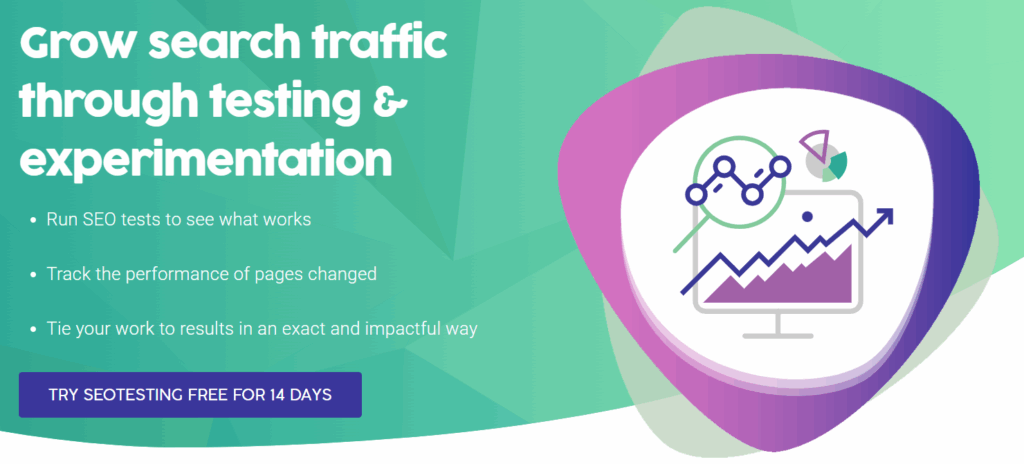Now that mastering a digital marketing strategy and achieving high content visibility is crucial to almost every single business in some way, shape or form, getting more eyes on your content has never been more important.
Google’s Discover has emerged as a powerhouse in this landscape.
Within this guide, we will talk about what Discover traffic is, how to get your content featured within Google Discover and how to track your content’s Discover appearances.
We will also delve into the Follow feature, from Google, explaining exactly what this is and how it works.
What is Discover Traffic?
At its core, Google Discover is a content recommendation platform, available directly within the Google app, designed to deliver a curated stream of articles, videos and other online content directly to users.
Google’s aim with Discover is to eliminate the need for active search queries. The idea behind Discover is that users can head straight into their Google app and be greeted with content that they will enjoy. Promoting them to click on this content and engage with it, overall creates a positive experience for Google, the publisher and, most importantly, the user.
The content suggestions presented on users’ mobile devices are based on:
- Past search behaviour.
- Location.
- Interests.
As well as other data points that Google think might be relevant. This results in a highly personalised browsing experience that Google hopes will promote user engagement and satisfaction.
Here is an example of Google Discover in action:
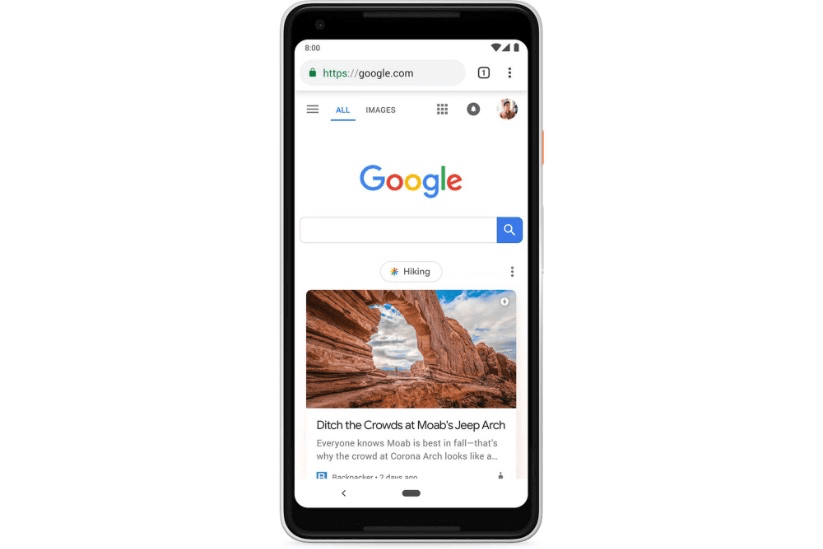
Image Credit: https://www.theverge.com/
The article appearing under the search bar is the first article shown in the Discover section. Users can scroll down this, find an article they like and click the hyperlink to be taken directly to that page.
How to Achieve Featured Content in Google’s Discover Section?
Getting your content featured on Google Discover, especially regularly, involves a combination of factors that align with both Google’s search algorithm and user preferences. Google, themselves, stress that there is no guaranteed formula, but following these guidelines can drastically improve your chances of being featured:
Create High-Quality Content
Creating well-researched, engaging, and original content that addresses user needs and interests is the crucial first step in getting content displayed on Google’s Discover section.
Google values content that provides value and relevance to its users. Especially when the content is written by true subject matter experts. This has become especially important following the expansion of EAT (Expertise, Authoritativeness & Trustworthiness) to EEAT (Experience, Authoritativeness & Trustworthiness). We also saw the move towards better content following the ‘Helpful Content Update’ Google released in 2022.
Write Compelling Page Headlines & Descriptions
Ensuring all of your content is complemented with a compelling page headline and description is a big step when it comes to getting Google to feature your content within Discover.
These elements have a direct impact on user engagement, click-through rate and the overall appeal of your content to potential readers.
It’s always been Google’s aim, with Discover, to provide users with personalised and relevant content recommendations, and headlines (as well as meta descriptions) play a significant role in capturing the attention of users and enticing them to click through your content.
Create Visual Appeal
Use high-quality images and visuals that truly complement your content. Eye-catching visuals can attract attention from users and encourage content engagement, which is another big factor in content being featured on Google Discover.
When using images within your content, remember to include “alt” tags so users with visual impairments can still understand your content fully if they have to use a screen reader. This is not just important from an accessibility standpoint, but also for Googlebot as the alt text within your images will help Google understand your content better.
Structured Data
Remember to implement structured data markup on your pages. This helps Google understand the content’s context and enhances the likelihood of rich snippets being featured in Discover.
This is not a requirement to be featured in Discover, but properly implementing structured data within your content is a great way to ensure Google can fully understand your content and what it is about. The more Google understands your content, the higher chance you have of receiving that coveted snippet within Discover.
Content Freshness
Google has made it clear that fresh and current information tends to perform better in Discover. Whether it is breaking industry news, new tips and tricks for completing certain tasks or anything out of the ordinary. Fresh content has a better chance of getting clicks when compared to evergreen content.
Regularly updating your content, keeping an eye out for content decay and ranking decay and fixing these issues when they arrive is a crucial steps in getting your content featured in Discover. Not only will this give brand-new content a chance to appear, but you will also increase the likelihood of older content being featured following an update, too.
Some Anecdotal Evidence from SEOTesting
Whilst Google has not explicitly mentioned this, we have found that getting social shares, especially to new content, has proved a good way of getting content featured on Google Discover.
As an example, we published our SEO Checklist article towards the end of July, and it was then shared by Aleyda Solis who is a huge name within the SEO and digital marketing industry. She shared the content via her Twitter and LinkedIn accounts on the 25th of July:
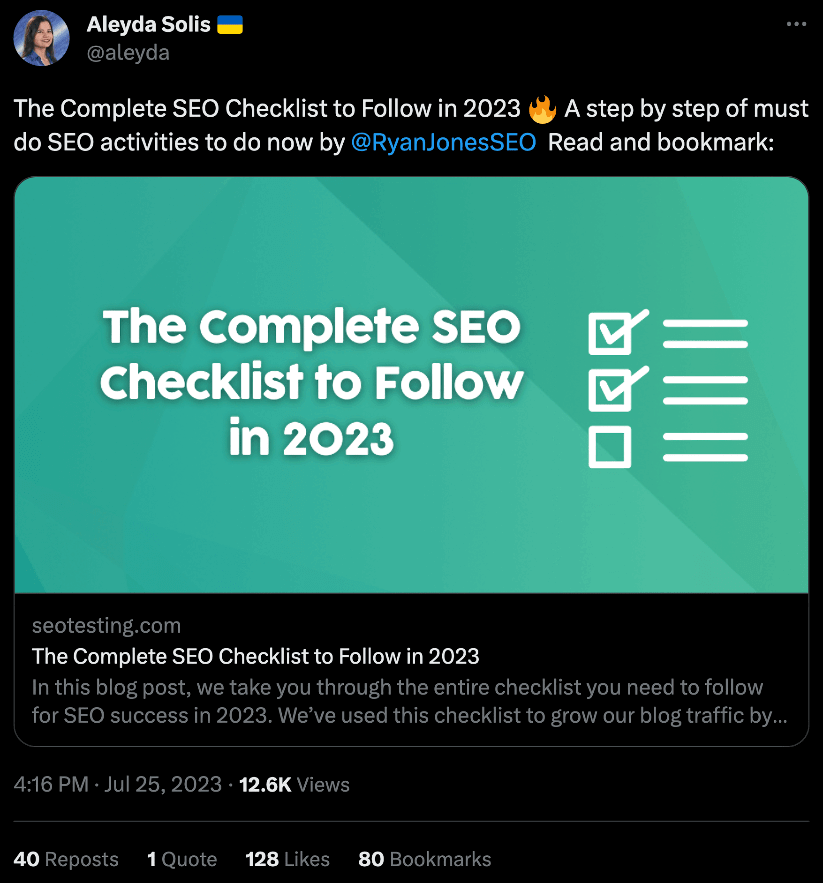
Here is the tweet from Aleyda, which resulted in:
- Approx. 12,600 views.
- 40 reposts.
- 1 “Quote” tweet.
- 128 likes.
- 80 bookmarks.
She also shared the article on her LinkedIn account:

Generating:
- 342 reactions.
- 10 comments.
- 38 reposts.
This led to the content being featured on Google Discover on the 26th of July, resulting in a huge spike in traffic to the page:
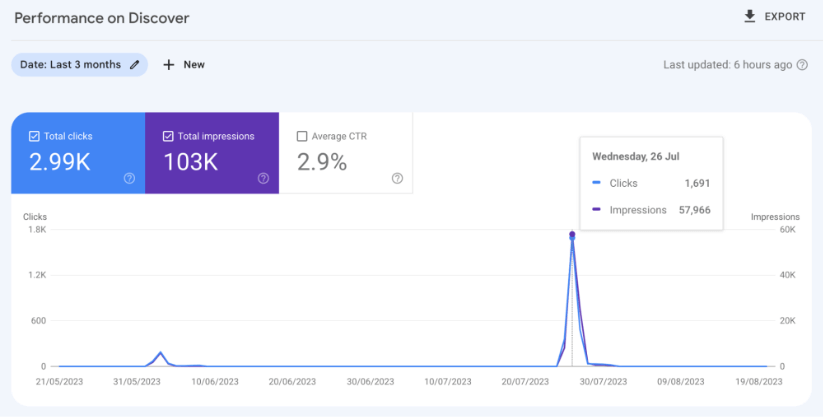
This spike in traffic ended up totalling around 2,400 clicks in 3 days. A record for SEOTesting!
How to Track Your Content’s Discover Appearances?
You will have seen a sneak peek of this above, but the best way to track your content’s appearances in Google Discover is by using Google Search Console. Specifically, the custom-built Discover section within your Google Search Console dashboard.
Once you open up Google Search Console, you will see the Discover tab on the left-hand side of the page, within your performance reports section:
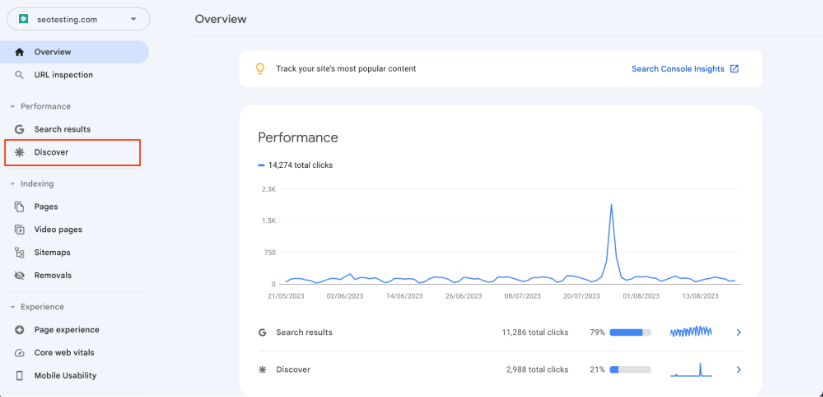
Once you have clicked on this, you will be greeted with your Discover report:

This chart will allow you to track the clicks, impressions and CTR you have received exclusively from Google Discover over a set period. The screenshot above shows our Discover performance in the last 3 months leading up to today, 22nd August at the time of writing.
You can see the content has had nearly 3,000 clicks and 103,000 impressions at an average click-through rate of 2.9%.
Scrolling further down the report, you will be able to go into more granular detail:

Here, you will be able to see the pages that have appeared in Google Discover, the countries it has appeared in, and the dates your content was featured in Discover.
You will also be able to see your “Discover Appearance” report, which tells you what type of content you have featured in Discover.
Google’s Follow Feature
Google’s Follow feature is a way for users to stay updated on the topics they are interested in and care about, directly within the Google app on their mobile devices. It allows users to follow specific topics, interests and even specific content creators. This will allow them to receive personalised recommendations and updates related to those subjects and creators.
The feature is designed to enhance the content discovery experience for users by curating a feed of information which has been completely tailored to their preferences and interests.
Users have control over the topics and creators they follow. They are also able to add new topics and creators, as well as remove existing ones as their interests change and develop over time, giving users complete control over their content interests.
The content curated through Google’s Follow feature will then appear in Google’s Discover feed. This will then provide users who use the Follow feature with a continuous stream of recommended content based on the user’s followed topics. Of course, the content that does appear in Discover may not all be exclusively related to the topics they follow, but the content will be relevant to the topic in some way. For instance, a user who has selected digital marketing as a topic might also be recommended technology news from time to time if it relates to digital marketing.
Google Discover FAQs
What is Google Discover traffic?
Google Discover traffic comes from users engaging with your content in the Discover feed of the Google app. This feed shows personalized content based on search history and interests.
How do I get my content featured in Google Discover?
Create helpful content with strong headlines, visuals, and fresh updates. Make sure your site uses structured data and is mobile-friendly.
Does structured data help with Discover visibility?
Yes. Structured data helps Google understand your content. This improves your chances of being featured, though it’s not a strict requirement.
Do social shares help content get into Discover?
Anecdotally, yes. Shares by well-known creators can help generate traffic spikes. These may trigger Discover inclusion.
How can I track my Discover traffic?
Use the Discover performance report in Google Search Console. It shows clicks, impressions, and CTR from Discover over time.
What is Google’s Follow feature?
The Follow feature lets users follow topics or creators. This content appears more often in their Discover feed.
Hopefully, you now have enough knowledge about both Google Discover and Google Follow that you can now go out and create amazing content which will be featured, bringing in more traffic to your website, which then hopefully leads to more revenue for your business.
We’ve explored what Google Discover is, and how you can get your content featured within Google Discover and we’ve also talked about the Follow feature from Google and how this relates. All that’s left for you to do now is go out and execute the information we’ve provided you with!
Looking to make more of your Google Search Console data? Give SEOTesting a try! We make SEO testing easy, for the masses, allowing you to bring in more traffic to your business and more buy-in for your future SEO work from your bosses/clients. We currently have a 14-day free trial with no credit card required to sign-up.
